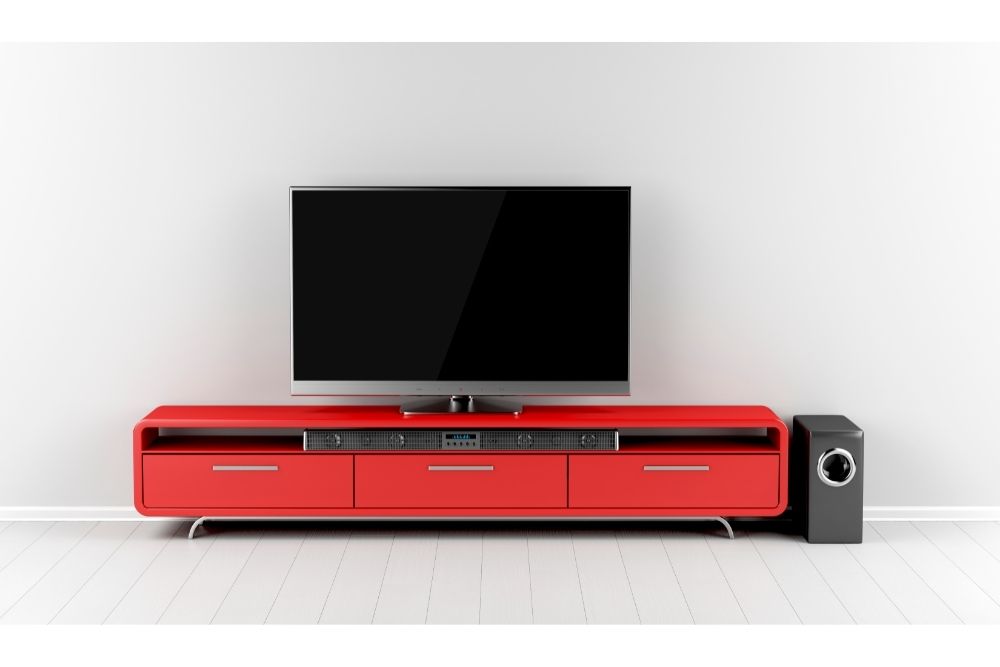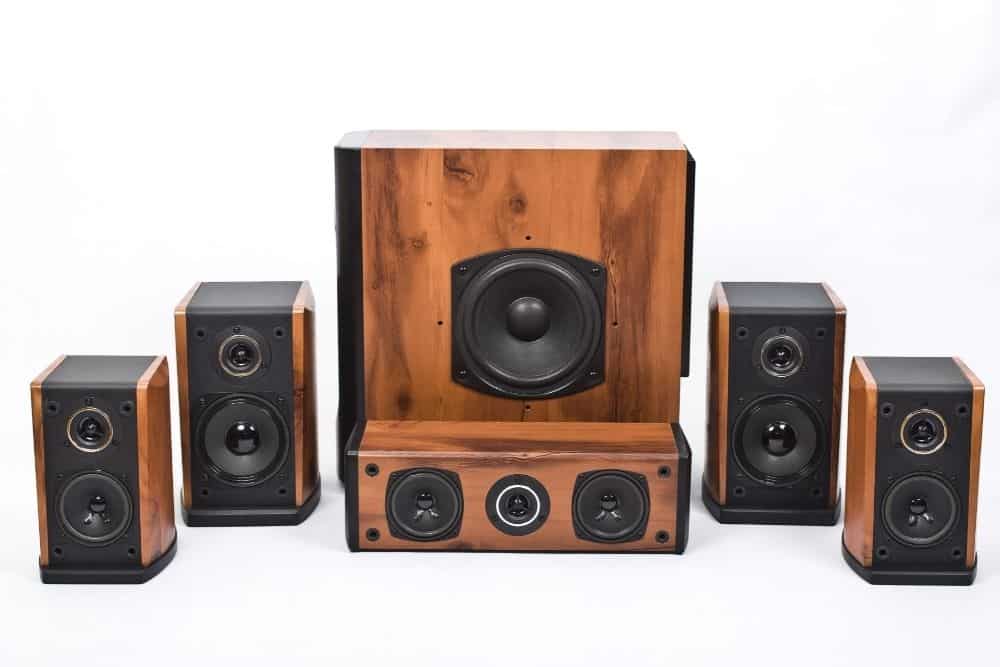Buying a subwoofer is like buying a bomb.
It’s all very well to own one, but it’s what you do with it that counts.
And what you do with a subwoofer is currently the subject of a war of ideas as to should subwoofer be in front or back?

Here’s why. The traditional faction has always declared that a subwoofer should be along the front wall of a room. On that basis, wherever you are in the room, it creates enough bass to give you the grunty, gut-crunching feeling of bass in music, or the believable rumble, growl, thump, or explosion effects you’re looking for from the action/war/superhero/sci-fi movie of your choice.
This probably makes most sense if you think of a home theater setup. Big bass sounds, like explosions, if they come at you from the same direction as the images of the thing that’s exploded, make connections in your brain and give you a split second to prepare for them, allowing you to brace against them as if they were real.
Explosive sounds coming at you from behind are more likely to unnerve you. But more than that: given that most human ears are at least slightly front-facing, if you’re facing the screen, the subwoofer bass sounds from behind will actually hit your ear as reflected sound from the front of the room anyway.
Paying subwoofer prices for reflected sounds? Where’s the sense in that?
Also, if you move all your bass sounds to your subwoofer as an audio focus on that front wall, you free up your other front speakers to focus on mid- and high-range frequencies. Having them all in a sonically similar place, blasting the sound forward towards your ears, makes sense in terms of the balance of the harmonics.
That’s the traditional view – and in the context of home theater, it’s relatively easy to see the sense it makes.
Omnidirectional subwoofer sounds
The newer, non-traditional view, is that most deep bass sounds – the subwoofer range of sounds – are ‘omnidirectional.’ Annoyingly for traditionalists, there’s some scientific truth in this. When you get down to roughly 80 Hz and below, the human ear has difficulty determining exactly where the sound is coming from, loud as it may be.
But where this gets interesting is in the dimensions of the rest of your speaker setup. Because the validity of the ‘omnidirectional’ hypothesis holds true only under certain conditions. If you’re using fairly small speakers in the rest of your setup (say, for example, with woofers that are 4 inches in diameter or less), they won’t do enough to push the subwoofer sounds under that 80 Hz threshold.
That in turn means you’ll be able to pick up the bass sounds as a thing distinct from the sound mix – which makes positioning of the subwoofer important again.
So before you go picking out random points around the room for your subwoofer on the basis that all the subwoofer sounds are omnidirectional anyhow, you’d better ask yourself: do you have the woofers to pull it off?
Because if you don’t, sure you can place your wireless subwoofer on a shelf at the back of the room. But you’ll be wasting your subwoofer money, because you won’t get the thunder-rolling, stomach full of butterflies feeling you expect and deserve from having paid for a subwoofer.
In fact, if you do that, what you’ll get is main speakers that are strangely timid when it comes to the bass, only for the distant subwoofer to pound in later, confusing the living daylights out of everything. Imagine the bassist is stoned. It’s hard, we know. That’s the kind of vibe you’re asking for with insufficiently wide woofers and a hidden sub.
Subwoofer in a corner
Another idea people have had – because sure, it might be worth trying – is putting their subwoofer in a corner.
Here’s the thing with that. If you’re just out for mega-bass with low distortion – and you may well be, because some whole genres of music live and breathe for that feeling – that’s not a bad idea. If you have larger speakers overall (again, we implore you, won’t somebody think of the woofers?!), you might be onto something.
The smaller your speakers though, the more putting your subwoofer in a corner becomes an idea that makes audio addicts wince. You may not hear it, and you may not care – again, if you’re all about the bass, go hog wild, though if you’re all about the bass, why you wouldn’t want the bass relatively front and center, we’re not sure.
But putting the subwoofer in a corner if you have smaller speakers means the subwoofer’s going to have to work harder to get a smooth blend with the other speakers. Sounds like nothing when you read it, we know. But the more you try it, the more you’ll hear the fragmentation, like silk brushed the wrong way.
Big speakers? Sure, you can try the corner placement thing – if the subwoofer’s not too far away from either the front left or front right speaker, you might well get a decent effect from it. But if your speakers are on the smaller side, follow the advice of Patrick Swayze, and never put Subby in a corner. That was what he said, right?
So what are we saying? Basically just never buy small speakers, they’re a crime against ears? No, absolutely not that. Part of the point of having a subwoofer is that if you place it correctly, it can lift the game of smaller speakers.
It can make them sound bigger than they are, so the whoomph of the subwoofer doesn’t sound so much like a distinct audio source, but more like part of a whole, organic, soundscape coming at you.
But with smaller speakers, it’s much more important not to overthink the decision. Much more important not to try to be too clever. Because nine times out of ten, you’ll have gone out the other side of clever, into that unfortunate space where you’ve spent good money on a subwoofer – and then made it next to useless.
Finding subwoofer perfection

Start out by believing the traditionalists. Yes, they’ll get smug, but you were more or less running that risk the moment you brought a subwoofer home. Initially, put your subwoofer 4 or 5 feet from the left or right front speakers. If you want some very smug traditionalists, put it between the two.
See – and indeed, hear – how that feels. Spoiler alert – the chances are pretty high it will feel like a smoother, more inherently ‘right’ bass sound and vibration coming at you. We know, we know, but they’re smug for a reason…
If you then want to progressively annoy and disturb the traditionalists – which is a pretty joyful way to spend a weekend – try moving the subwoofer say 5 feet from its original position. Observe the difference. Then do it again, moving the sub to a different position, roughly the same 5 feet away from the original.
Note the difference again. Keep doing that until you find a position that you really live and breathe for, or until the heads of your traditionalist friends have exploded. Seriously, it shouldn’t take a whole weekend, but pace yourself and do the job right.
If you especially want to punish traditionalists and your system comes with an auto speaker calibration, run it every time you change the position of the subwoofer. Granted, the likelihood of getting a truly optimized position with an auto-calibrator isn’t high, but it’ll give you some interesting (if not always accurate) data to compare with your subjective experience.
Subwoofer life hack
Technically, this should annoy traditionalists less, but if you have the time and the patience, you could always grab the manual that comes with the subwoofer and try to run a manual calibration every time you move the subwoofer. Will you really get an optimized performance position that way? The Magic 8 ball of sonic reproduction says “Prospects not encouraging.”
If you’ve tortured your bearded friends enough for one weekend though, there is quite a neat subwoofer lifehack you can use.
The whole “move the subwoofer around by 5 feet and test your reaction” thing is fun for a while, but you’ll get a much faster answer to the dilemma by flipping the whole experiment on its head.
Put the subwoofer where you’ll typically be when you’re listening to it do its thing. Crank up some bass-heavy music (We like to use WAP, by Cardi B, featuring Megan Three Stallion, because it not only gets the job done but also scandalizes the neighbors. Your neighbors may vary), and blast it.
What you have then is a setup where instead of you staying still and the subwoofer moving, the subwoofer can stay still, and you can move around the room.
When you find the spot where the sound and the vibration are at their sweetest and dirtiest, and the synchronization of the speakers makes you smile or weep with happiness, leave a marker – a paper plate, a bunch of keys, it doesn’t matter what.
In the event that there’s more than one spot in the room where you need to get maximum bass, repeat the process and find the new sweet spot.
We’re not really about compromising on perfection, but if you’re regularly going to use both or all of the chairs in the room, and entirely at your own risk of disappointment, you can try positioning the subwoofer at the midpoint or confluence point of your sweet spots.
So where, ultimately, should your subwoofer be positioned? The traditionalists may be smug, but they have a point – certainly if the room in question is a home theater – from and center is a pretty great place to put your sub.
If you’re not fitting a home theater, the question gets more complex, and will depend on the size of your speaker setup (Woofers!), the shape of the room (Don’t get us started on multipath sound waves or we’ll be here all day!), and ultimately, where the sweet spot is for you.
